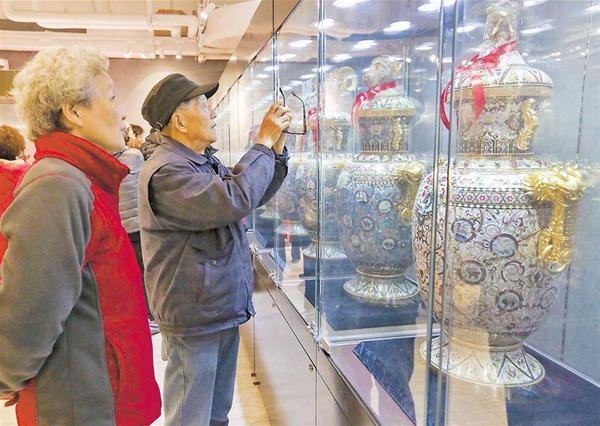
Cloisonne
enamel artefacts make for a dazzling sight for visitors at Shanghai
Dashijie amusement center yesterday. Masters are on hand to teach
intangible cultural heritages. — Wang Rongjiang
Inheritors of China’s traditional skills have been invited to the century-old Shanghai Dashijie amusement center — which now becomes an exhibition center for China’s intangible cultural heritages — to display and teach visitors skills during its trial operation, officials said yesterday.
They include masters of cloisonne enamel from Beijing, Shanghai embroidery as well as bamboo weaving, brick carving, dough sculpture and paper-cutting.
The inheritors are exhibiting their masterpieces and performing skills on the second floor of the building, also known as the Great World Amusement Center, on Xizang Road South in Huangpu District until the end of March.
The inheritors and their exhibitions will be changed monthly in a bid to attract the public, especially younger people to enjoy the traditional skills, said an official with the center’s preparation team.
The new batch of masters at the centerpiece Original Intangible Cultural Heritage Hall include Zhang Tonglu, the inheritor of Beijing cloisonne enamel, Qian Yuefang, master of local-style embroidery originated from Ming Dynasty (1368-1644) in Songjiang District, He Fuli, the inheritor of bamboo weaving from neighboring Zhejiang Province, and Li Jinbo, a young paper-cutting master from east China’s Shandong Province.
All these experts’ skills are listed as national intangible cultural heritages.
Li yesterday showed how to cut hair-like patterns on a piece of red paper using an ordinary pair of scissors.
“The secret is to control your breath rather than the scissors,” he taught visitors, mostly middle-aged locals.
“To acquire the skills, I often sing Peking Opera to practicing the breath control.”
Qian gave a lecture to introduce the history of local “Gu embroidery.” She then invited visitors to follow her in embroidering simple patterns on a handkerchief.
“Shanghai embroidery is not as famous as that of neighboring Suzhou City, and the center offers a great platform to promote the skill,” she said.
Several historic cloisonne enamel examples have been exhibited in the hall, including a set of five cloisonne wares from the late Qing Dynasty (1644-1911) which were used by nobility for sacrifice rituals.
The Dashijie entertainment center was built in 1917. It closed in 2003 and has reopened for the trial operation since December 28. It is now only serving invited visitors, including local students and some senior residents.
An official said the date for its official opening and the ticket price had yet to be decided. About 1,000 visitors will initially be invited to enter the building daily on working days, and the number will be doubled on weekends. The building is able to receive a maximum 3,300 visitors simultaneously.
The Huangpu District government has begun soliciting public opinions on the ticket price. The government-suggested price is between 60 and 80 yuan (US$8.75 to US$11.67).
The center also has an open-air middle stage area, just as the amusement center had before it closed. Traditional Chinese operas and local oral performances are being staged at 1pm, 3pm and 7pm daily.
